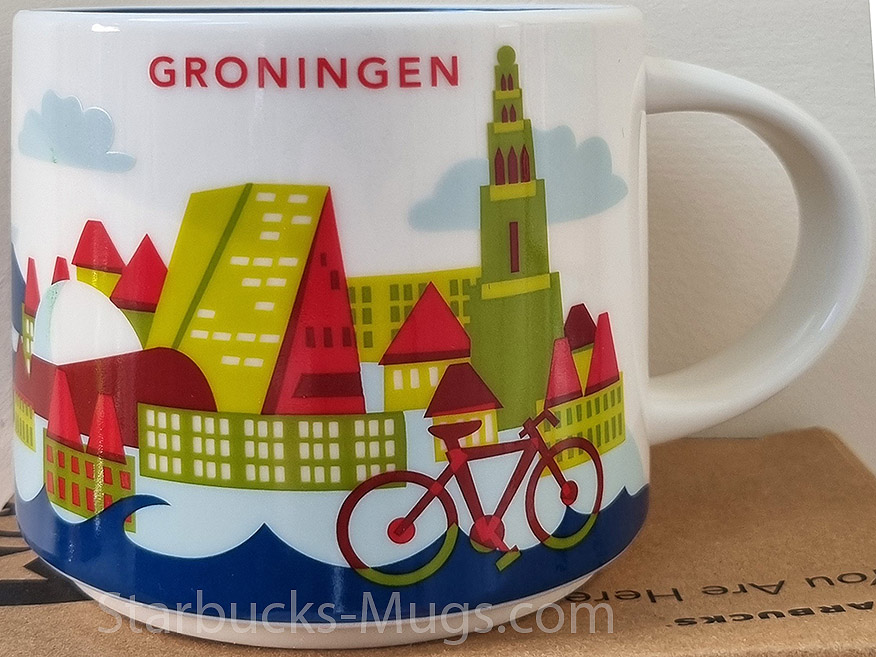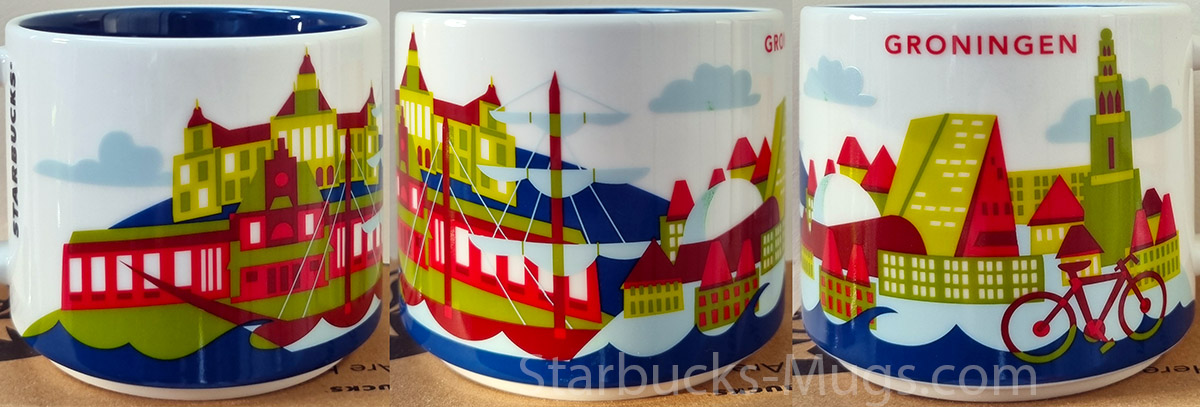
You Are Here – Groningen
Starbucks You Are Here – Groningen comes from the Netherlands. Big thanks to the blog reader for providing the pictures of this beautiful mug!
Groningen, a vibrant city in the northern part of the country, boasts a rich history dating back to the 11th century when it emerged as an influential regional trade hub. The city’s strategic location allowed it to thrive during the Middle Ages, becoming a member of the powerful Hanseatic League. This affiliation boosted its economic and cultural significance, fostering connections with other major European cities. Groningen is also home to the University of Groningen, founded in 1614, which has played a pivotal role in the city’s development and reputation as a center of education and innovation. The cityscape is a blend of historic buildings, such as the Martinitoren, and modern architecture, reflecting its dynamic and forward-thinking character. Today, Groningen is known for its lively cultural scene, green initiatives, and as a hub for research and technology, maintaining its historical legacy while shaping a sustainable and progressive future.
Here are some landmarks of the city as seen in the design of the mug:
– The Martinitoren is the tallest church steeple in Groningen, standing at an impressive 318 ft (97 meters). It dates back to the 15th century and has survived fires and lightning strikes over the centuries. Climbing the tower provides visitors with panoramic views of the city and surrounding countryside. The tower’s bells, which have rung out over Groningen for centuries, are an iconic part of the city’s soundscape.
– Founded in 1614, the University of Groningen is one of the oldest and most prestigious universities in the Netherlands. Its historic buildings, like the iconic Academy Building, reflect the university’s long-standing tradition of academic excellence. The university has played a crucial role in the city’s development, contributing significantly to Groningen’s reputation as a center of education and innovation. It attracts students and scholars from around the world, fostering a diverse and dynamic academic community.
– The Aa-Kerk is a medieval church that has played a significant role in Groningen’s religious and cultural history. Originally built in the 13th century, it has undergone several renovations and expansions over the centuries. The church’s towering spire and striking Gothic architecture make it a prominent feature of the city’s skyline. It is now used as a cultural venue, hosting concerts, exhibitions, and other events that draw both locals and tourists.
– Forum Groningen is a dynamic cultural and educational center located in the heart of the city. Opened in 2019, this modern architectural marvel houses a variety of facilities, including a library, cinema, exhibition spaces, and a rooftop terrace with stunning views of Groningen. The Forum serves as a vibrant community hub, offering a diverse range of events, workshops, and activities that cater to all ages and interests. Its innovative design and multifunctional spaces make it a landmark destination for both locals and visitors, fostering creativity, knowledge, and cultural exchange.
– While the city of Groningen itself is located inland, it is linked to the North Sea through the Ems River and various canals. The Ems River, which forms part of the border between the Netherlands and Germany, flows into the North Sea, providing a waterway connection. Additionally, the Eemskanaal and other smaller canals facilitate access between Groningen and the coastal regions, supporting both commercial and recreational maritime activities. This connectivity has historically been significant for trade and transportation, contributing to the city’s development and economic growth.
– Groningen, like many cities in the Netherlands, is renowned for being exceptionally bike-friendly. The city boasts an extensive network of dedicated bike lanes, making cycling a safe and efficient mode of transportation for residents and visitors. With its flat terrain and compact urban layout, Groningen is ideal for cyclists, who often outnumber cars on the streets.




































































